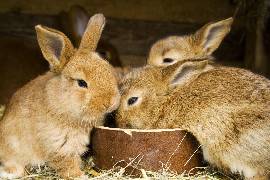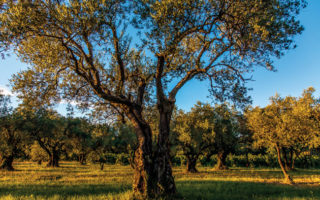Rearing Rabbits
Advice


Rabbits in France are as commonplace at supermarket meat counters as chickens, and they are also sold at street markets as livestock. Why?
The Upside
Once you let go of the image of the fluffy tailed friend from ‘Watership Down’ and get down to reality, you will find that rabbit it is a good source of quality protein for the family diet.
Rabbits are a much more commonsense form of livestock than many give it credit for.
A rabbit can reach a respectable 1.5 kilos dead weight in about 12 weeks from birth and on nothing more than good pasture during the spring and summer, supplemented with a little preparatory feed to help keep it from worm infestation.
A rabbit will cost us less than an a euro to get to market weight and sell for 8€ to 14€ each, or feed four adults for dinner with some left over for Moss (our dog.)
The Downside
I don’t believe there is one. Parasites are your only enemy, and baby rabbits are very susceptible to Coccidiosis and will die from the effect of infestation. Feed some preparatory feed as well as allowing them to graze on some pasture, keep them clean so they are not walking on their own fesses and you should have no real problems. In fact I think rabbits are the easiest of all livestock to keep and if you can’t manage rabbits you should think twice about keeping any livestock at all.
Getting Started
Most good French street markets will have a section where smallholders sell their produce direct to the public. It’s both informal and sociable. Have a good look around the whole market, take in the atmosphere and then return to any vendors who are selling rabbits.
I enjoy my livestock and so should you so choose rabbits – as with any livestock you intend to keep – that you actually like the look of. Buy your female/s from one vendor and your male from another selling the same breed or even go to another market in a different area. This ensures good variation in the rabbit gene pool
One male and two females will provide a family of four with all the white meat they can eat in a year, and although the taste of the meat is not the same as chicken you can use rabbit meat in any recipes you would normally use chicken in.
Feeding
Firstly arrange your housing so your rabbits have access to pasture. This is easily achieved by keeping your rabbits in movable arks with a wire mesh floors. Move them every day when you have just one rabbit in it and when the females have babies move it two or three times a day as the babies grow. You can feed grain to rabbits to save money but you will have to make sure your rabbit has some form of ‘Coccidiostat’, the medication that protects them from Coccidiosis. I prefer to give them some preparatory feed that already contains the medication as a cover all.
Rabbits also need a constant supply of clean water; don’t underestimate it, or they will die.
Housing Needs
I have already mentioned movable arks and to my mind it seems only logical to try to imitate the natural behaviour of any animal. I would agree with anyone who says free range is best for all animals. Rabbits however will dig their way out of any enclosure you build unless you bury 60cm of your fencing below ground, and even then some will succeed in escaping. Movable arks with wire mesh floors will give you security for your stock and allow your rabbits to eat natural food.
In the two pictures below you can see an example of a good design of a movable ark. It has economy of materials but gives a good amount of floor space for the rabbit to feed from. It provides a dry wind proof shelter for the rabbit in cold wet weather and if orientated well it will give some shade throughout the day.
There are of course many other ways to keep rabbits and if you prefer to build high rise apartment block type accommodation, you can still have healthy well kept rabbits. I would not wish to live that way myself, and I prefer to eat meat from animals that have been given the best food and conditions possible.
You will need an ark for each adult rabbit and another for each of the females as this will give you somewhere for the babies to be moved to before they reach 12 weeks of age. If you can it is best to separate males and females at this time, so no unwanted pregnancies occur.
Breeding
Breeding rabbits is easy. As the saying goes ‘they breed like rabbits’ and rabbits deserve their reputation, so much so that preventing breeding is as important as breeding itself.
Does (females) are mature and ready to mate at just 20 weeks and bucks (males) at 25 weeks, however both can mate successfully at much younger ages if allowed to stay together.
Breeding is as simple as putting the buck with the doe but then you have a decision to make – do you separate them as soon as the doe is served (copulated) or do you let the buck have a little more fun?
I tend to prefer nature’s way and in natural surrounding males would linger with the doe for days, but commercially males are put to the doe for minutes before separation, returned ten hours later for a second serving and then the female is left to her own devices. Rabbits do not have a cycle, as do most mammals. Instead they simply respond to copulation by producing eggs so it is a good idea for the male to be given more that one chance to copulate in the region of ten hours after first copulation.
Gestation (pregnancy) lasts for 31 days; a day or so before your doe is due she will pull out most of the hair from her breast and start to make a nest with it. If you keep good notes as to the date of serving you can make sure your rabbit’s sleeping area is cleaned out 3 days prior to birth and new bedding material out in so your new babies arrive into a clean hygienic home. Once kindling (birth) starts, it is best to leave your doe alone, disturbing her as least as possible. From this point on start to move the cage twice a day to give her access to more food allowing her to gain enough nutrition to feed her young.
You can leave the young with their mother for as long as you like, but be aware bucks will try to mate with their sisters and mother long before they are fertile. The does will lose hair and the bucks will continually serve any available female. I have known smallholders who have had babies from 16-week-old stock who had been left together for want of extra housing.
Steve Hanson
Share to: Facebook Twitter LinkedIn Email
More in courses, cycling, food, holiday accommodation, markets, summer, walking
By FrenchEntrée
Leave a reply
Your email address will not be published. Required fields are marked *



